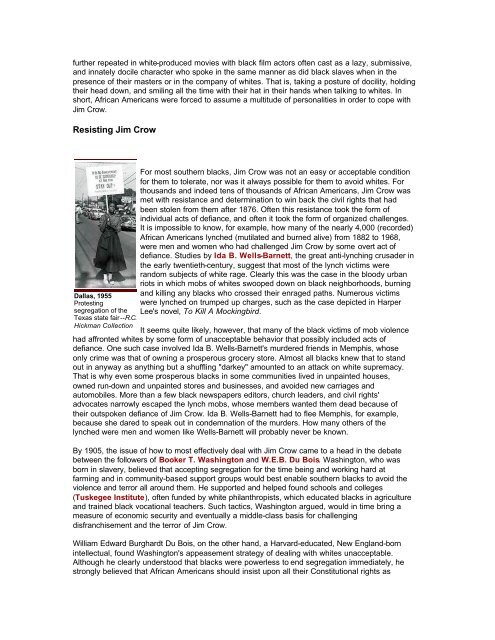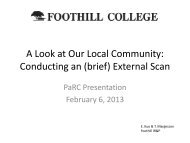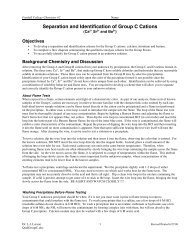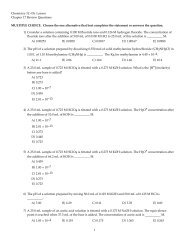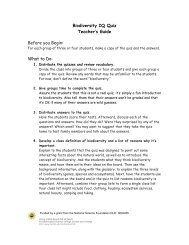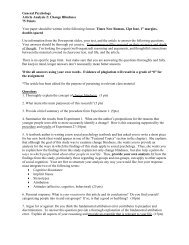From Terror to Triumph: Historical Overview - Foothill College
From Terror to Triumph: Historical Overview - Foothill College
From Terror to Triumph: Historical Overview - Foothill College
You also want an ePaper? Increase the reach of your titles
YUMPU automatically turns print PDFs into web optimized ePapers that Google loves.
further repeated in white-produced movies with black film ac<strong>to</strong>rs often cast as a lazy, submissive,<br />
and innately docile character who spoke in the same manner as did black slaves when in the<br />
presence of their masters or in the company of whites. That is, taking a posture of docility, holding<br />
their head down, and smiling all the time with their hat in their hands when talking <strong>to</strong> whites. In<br />
short, African Americans were forced <strong>to</strong> assume a multitude of personalities in order <strong>to</strong> cope with<br />
Jim Crow.<br />
Resisting Jim Crow<br />
Dallas, 1955<br />
Protesting<br />
segregation of the<br />
Texas state fair--R.C.<br />
Hickman Collection<br />
For most southern blacks, Jim Crow was not an easy or acceptable condition<br />
for them <strong>to</strong> <strong>to</strong>lerate, nor was it always possible for them <strong>to</strong> avoid whites. For<br />
thousands and indeed tens of thousands of African Americans, Jim Crow was<br />
met with resistance and determination <strong>to</strong> win back the civil rights that had<br />
been s<strong>to</strong>len from them after 1876. Often this resistance <strong>to</strong>ok the form of<br />
individual acts of defiance, and often it <strong>to</strong>ok the form of organized challenges.<br />
It is impossible <strong>to</strong> know, for example, how many of the nearly 4,000 (recorded)<br />
African Americans lynched (mutilated and burned alive) from 1882 <strong>to</strong> 1968,<br />
were men and women who had challenged Jim Crow by some overt act of<br />
defiance. Studies by Ida B. Wells-Barnett, the great anti-lynching crusader in<br />
the early twentieth-century, suggest that most of the lynch victims were<br />
random subjects of white rage. Clearly this was the case in the bloody urban<br />
riots in which mobs of whites swooped down on black neighborhoods, burning<br />
and killing any blacks who crossed their enraged paths. Numerous victims<br />
were lynched on trumped up charges, such as the case depicted in Harper<br />
Lee's novel, To Kill A Mockingbird.<br />
It seems quite likely, however, that many of the black victims of mob violence<br />
had affronted whites by some form of unacceptable behavior that possibly included acts of<br />
defiance. One such case involved Ida B. Wells-Barnett's murdered friends in Memphis, whose<br />
only crime was that of owning a prosperous grocery s<strong>to</strong>re. Almost all blacks knew that <strong>to</strong> stand<br />
out in anyway as anything but a shuffling "darkey" amounted <strong>to</strong> an attack on white supremacy.<br />
That is why even some prosperous blacks in some communities lived in unpainted houses,<br />
owned run-down and unpainted s<strong>to</strong>res and businesses, and avoided new carriages and<br />
au<strong>to</strong>mobiles. More than a few black newspapers edi<strong>to</strong>rs, church leaders, and civil rights'<br />
advocates narrowly escaped the lynch mobs, whose members wanted them dead because of<br />
their outspoken defiance of Jim Crow. Ida B. Wells-Barnett had <strong>to</strong> flee Memphis, for example,<br />
because she dared <strong>to</strong> speak out in condemnation of the murders. How many others of the<br />
lynched were men and women like Wells-Barnett will probably never be known.<br />
By 1905, the issue of how <strong>to</strong> most effectively deal with Jim Crow came <strong>to</strong> a head in the debate<br />
between the followers of Booker T. Washing<strong>to</strong>n and W.E.B. Du Bois. Washing<strong>to</strong>n, who was<br />
born in slavery, believed that accepting segregation for the time being and working hard at<br />
farming and in community-based support groups would best enable southern blacks <strong>to</strong> avoid the<br />
violence and terror all around them. He supported and helped found schools and colleges<br />
(Tuskegee Institute), often funded by white philanthropists, which educated blacks in agriculture<br />
and trained black vocational teachers. Such tactics, Washing<strong>to</strong>n argued, would in time bring a<br />
measure of economic security and eventually a middle-class basis for challenging<br />
disfranchisement and the terror of Jim Crow.<br />
William Edward Burghardt Du Bois, on the other hand, a Harvard-educated, New England-born<br />
intellectual, found Washing<strong>to</strong>n's appeasement strategy of dealing with whites unacceptable.<br />
Although he clearly unders<strong>to</strong>od that blacks were powerless <strong>to</strong> end segregation immediately, he<br />
strongly believed that African Americans should insist upon all their Constitutional rights as


